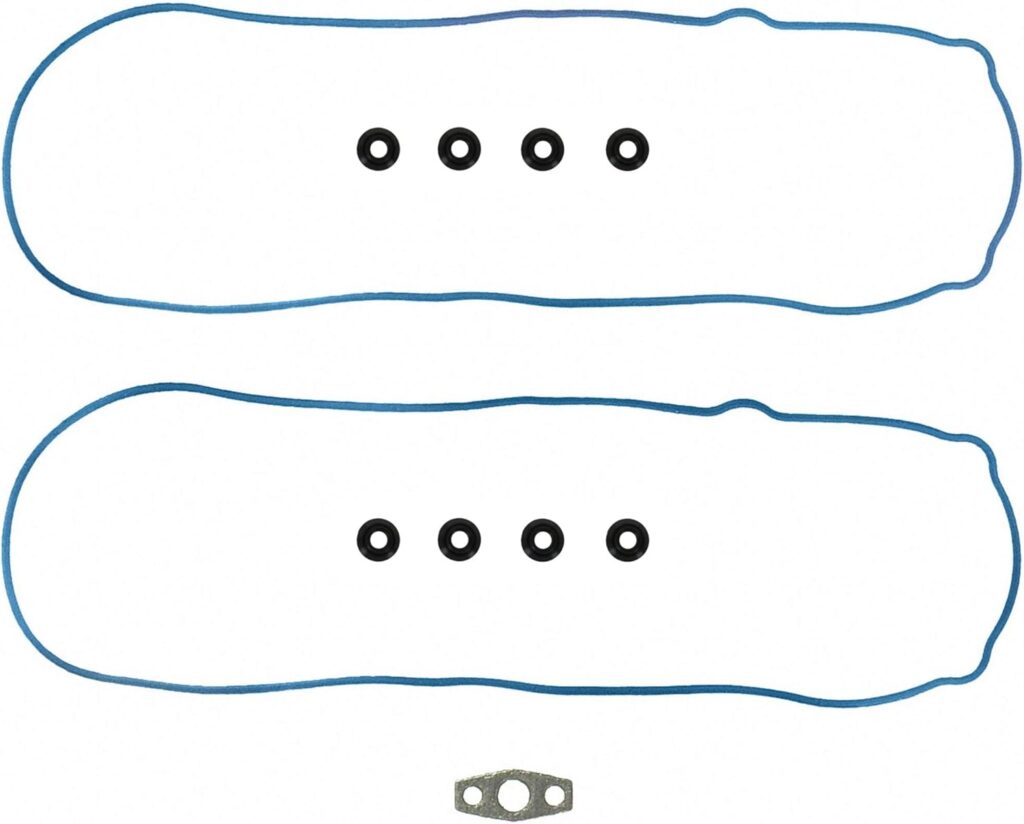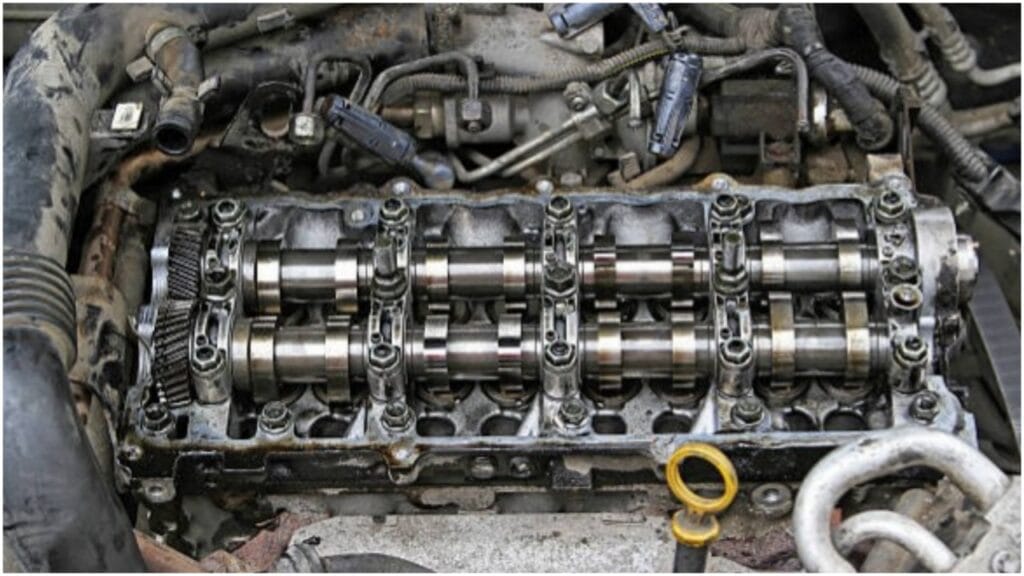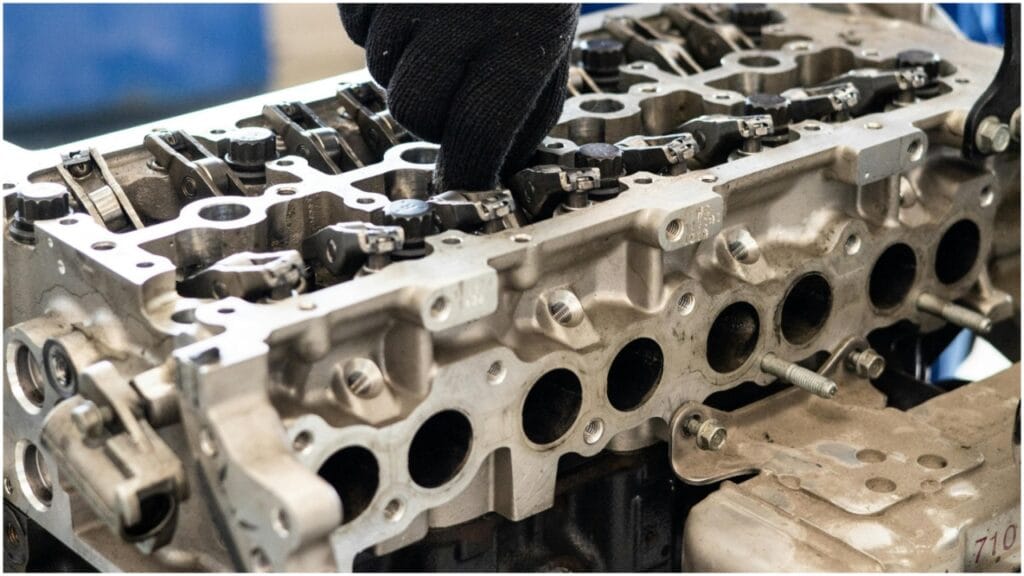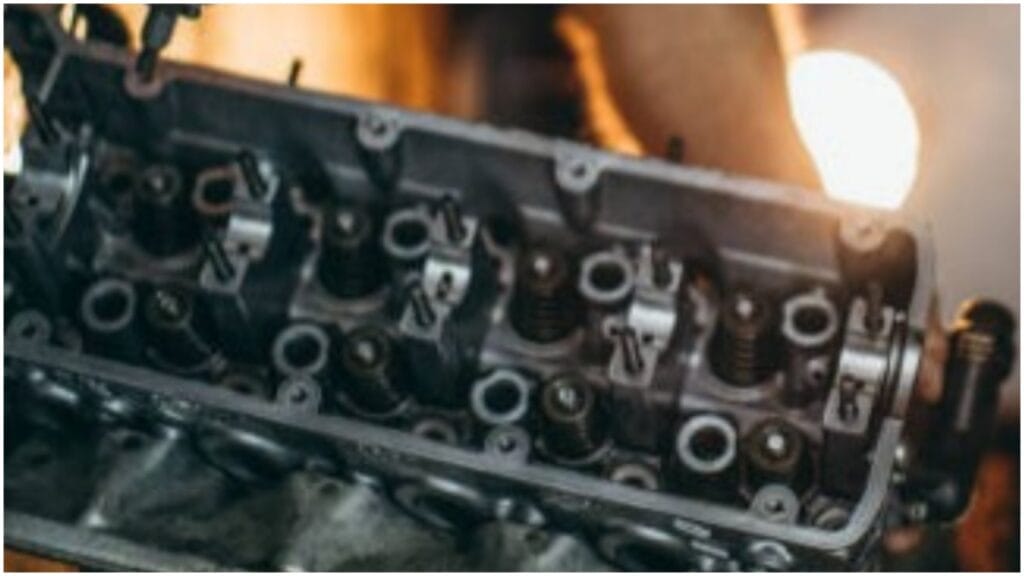The valve cover gasket is an important sealing element that sits between the valve cover and the cylinder head, preventing engine oil from leaking. Made of rubber, cork, or synthetic materials, it prevents dirt and debris from entering the engine. It is able to withstand high heat and pressure. Even so, with age, it can crack or shrink, potentially leading to oil leaks. This gasket needs to be replaced if there is an oil leak.

FEL-PRO VS 50504 R-1 Engine Valve Cover Gasket Set for Chevrolet Silverado 1500
How Does It Work?
The valve cover gasket is designed to maintain a perfect seal between the valve cover and the cylinder head, preventing oil from escaping. It’s not just about keeping the oil where it belongs, though.
The gasket also helps to prevent contaminants from getting into the engine. The inside of your engine needs to stay clean and lubricated, and the gasket ensures nothing messes that up.
When the engine is running, it produces heat and pressure. The gasket must be tough enough to handle these conditions without deteriorating or warping.
If it does, the seal breaks and oil begins to leak out. This can cause low oil levels, which, as you can imagine, is a severe issue for the engine’s longevity.
What Happens When the Valve Cover Gasket Fails?

The first thing you’ll notice is an oil leak. The oil will seep and pool around the engine if the gasket is worn out or damaged. You might also see dark spots or puddles under your car, indicating something is wrong. But it doesn’t end there.
A bad valve cover gasket can also increase engine temperatures since the oil circulating through the engine is leaking out. Without proper lubrication, parts like the valves and camshaft can overheat, eventually leading to a breakdown or severe engine damage.
Another thing to remember is that an oil leak could affect your car’s performance. If the oil levels drop too low, the engine won’t function at its best. You might notice strange noises, rough idling, or a loss of power. None of these are ideal.
Signs of a Valve Cover Gasket Problem
Is your valve cover gasket on the out? Here are some clues that it might be time to look closer.
- Oil Leaks: The gasket could leak if you notice oil pooling around the engine or oil stains where your car is parked.
- Burning Oil Smell: When oil leaks onto hot engine parts, it can burn off, creating that familiar burnt oil smell. Not only is it unpleasant, but it’s also a sign that something is wrong.
- Engine Misfire or Rough Idling: If oil leaks onto the spark plugs or other critical components, it can cause poor combustion, leading to rough idling or even engine misfires.
- Low Oil Levels: If you constantly have to top off the oil in your engine, it’s a strong indication that the valve cover gasket might be leaking.
Replacing the Valve Cover Gasket
The good news is that replacing a valve cover gasket is simple but requires some time and attention to detail. If you’re mechanically inclined, you could take on the task yourself. Just ensure you have the right tools and follow the steps to avoid causing more harm than good.
Here’s a simplified rundown of the process:
- Prepare Your Car: Make sure the engine is excellent, and disconnect the battery. You don’t want any surprises while you’re working.
- Remove Components: Depending on the car, you may need to remove the air intake, spark plugs, or electrical connections to access the valve cover.
- Take Off the Valve Cover: Carefully unbolt the valve cover. If it’s stuck, tap it gently with a rubber mallet.
- Clean the Surface: Before installing the new gasket, ensure the valve cover and the cylinder head surfaces are clean. Any leftover debris can cause leaks later on.
- Install the New Gasket: Place the new gasket onto the valve cover or cylinder head, depending on your vehicle’s design, and ensure it’s aligned correctly.
- Reassemble Everything: Bolt the valve cover back on, reconnect any components you removed, and top off the oil if needed.
After installing the new gasket, checking for leaks after running the engine is a good idea. Also, oil levels should be monitored, and any signs of fresh oil around the gasket area should be looked for.
Why It’s Important to Replace the Valve Cover Gasket Promptly

If you’re experiencing signs of a gasket issue, it’s essential not to ignore it. A small leak may seem no big deal, but it can cause more significant problems over time.
If left unchecked, a damaged gasket can lead to oil loss, engine overheating, and even complete engine failure. And believe me, dealing with those problems is much more expensive than replacing a simple gasket.
Maintaining an adequately sealed engine helps ensure your car runs at its best, which means better fuel efficiency and smoother performance. It’s an investment in your vehicle’s overall health.
The Materials Behind the Gasket
Valve cover gaskets aren’t made from just any material. They must withstand extreme conditions, so manufacturers use durable materials that won’t degrade quickly. The most common materials are:
- Rubber (or Elastomeric) Gaskets are the most traditional and commonly used valve cover gaskets. Rubber gaskets are affordable, flexible, and provide a solid seal. However, they can degrade over time, especially in high-heat environments, so they tend to be replaced more frequently.
- Cork Gaskets: Cork was a popular material for valve cover gaskets, but today, it’s primarily used in older vehicles. Cork gaskets provide an excellent seal but are more prone to cracking and drying out, leading to leaks.
- Silicone Gaskets: Many modern vehicles use silicone gaskets because they’re more heat-resistant and durable than rubber or cork. They also provide better sealing properties, making them ideal for high-performance or heavy-duty engines.
- Composite Gaskets: Some valve cover gaskets are made from a blend of rubber, silicone, and even metal for added strength and longevity. These can be found in newer vehicles and high-performance engines, where heat and pressure are constant concerns.
Each material has pros and cons, but silicone and rubber gaskets are generally the most commonly used in newer cars.
Why Do Gaskets Wear Out?
All gaskets have a shelf life, and the valve cover gasket is no different. Over time, heat, pressure, and exposure to oil can cause the gasket to degrade, harden, or crack. When this happens, it no longer creates an effective seal, and you start seeing leaks.
A few factors that contribute to gasket wear and failure include:
- Heat: Engines generate a lot of heat, and the valve cover gasket is subjected to extreme temperatures. Constant heating and cooling cycles cause the material to expand and contract, which can eventually lead to cracking or hardening.
- Age and Mileage: Like any component in a vehicle, the valve cover gasket’s lifespan is limited. The material naturally degrades as the car racks miles, and the gasket becomes more prone to leaks.
- Incorrect Torque: When installing or reinstalling the valve cover, the gasket may only be compressed evenly if the bolts are tightened to the proper torque specification. This can lead to uneven sealing and eventual leaks.
- Oil Contamination: If oil gets contaminated (for instance, from debris or engine coolant leaks), it can deteriorate the gasket material. The oil can also make the gasket soft and pliable, reducing its sealing effectiveness.
The Function Beyond the Seal
Although the valve cover gasket’s primary purpose is sealing, it supports keeping your engine operating efficiently. Here are a few ways the gasket fits into the overall performance of the engine:
- Oil Containment: The gasket ensures that oil stays inside the engine’s valve cover, where it’s needed to lubricate the valve train. Oil could leak out without the gasket, and the engine would suffer from reduced lubrication.
- Pressure Management: As the engine operates, pressure is created in the combustion chamber. The valve cover gasket helps maintain appropriate pressure within the engine by preventing external air or contaminants from entering the system.
- Prevention of Contaminants: Beyond oil, the gasket prevents dirt, dust, and other environmental debris from getting into the engine. A contaminated engine can lead to premature wear and a significant loss in performance.
- Emission Control: Modern engines are designed to be more environmentally friendly. The valve cover gasket helps prevent unburned fuel and oil vapors from escaping, which could contribute to air pollution. Some valve covers also integrate PCV (positive crankcase ventilation) valves, which help manage emissions by rerouting oil vapors into the engine’s intake system. A faulty valve cover gasket can disrupt this system, leading to poor emissions performance.
Types of Engines and Valve Cover Gaskets

Not all engines are created equal, and valve cover gaskets can vary significantly depending on the engine type.
- Inline Engines: These are engines where the cylinders are arranged straight. The valve cover gasket is typically straightforward for these engines—a simple rubber or silicone gasket that fits tightly around the cover and cylinder head.
- V-Engines (V6, V8, etc.): In V-type engines, the valve covers are usually split into two halves—one for each bank of cylinders. This means the valve cover gasket is often more complex, with two separate gaskets or one large gasket that seals both sides. V-engines can present unique challenges in gasket design due to the two separate valve cover areas.
- Flat or Boxer Engines: These engines have flat cylinders, often horizontally opposed to each other. The valve cover gaskets in these engines tend to be different in shape and design, often requiring more precision due to the engine’s low profile and unique layout.
- DOHC vs. SOHC Engines: In engines with Dual Overhead Camshafts (DOHC), the valve cover gasket must accommodate more complex designs because more moving parts are within the valve cover. On the other hand, Single Overhead Camshaft (SOHC) engines are simpler in design, and the valve cover gasket tends to be less complicated.
Maintaining the Valve Cover Gasket
Since valve cover gaskets are subject to wear, there are a few preventative measures you can take to prolong their life:
- Routine Inspections: Regularly checking your engine for oil leaks or signs of damage around the valve cover can help you catch a gasket issue early. Even if there’s no immediate oil loss, it’s wise to visually inspect the gasket area for any oil residue or signs of wear.
- Change Your Oil Regularly: Dirty oil can degrade the gasket material over time, so maintaining good oil hygiene is critical. Clean oil keeps the gasket in better condition and ensures the engine is properly lubricated.
- Don’t Over-tighten the Bolts: When performing maintenance around the valve cover area, follow manufacturer specifications when tightening bolts. Over-tightening can stress the gasket, leading to warping and leaks.
- Use the Right Gasket: When replacing the valve cover gasket, use one made of the appropriate material for your engine. If you need more clarification, it’s best to consult a mechanic or refer to your vehicle’s manual.
What does a valve cover gasket do?
A valve cover gasket is a small but essential part of your engine. It sits between the valve cover and the engine head, creating a tight seal.
Its main job is to keep the engine oil inside while preventing dirt and debris from getting in. This helps lubricate the moving parts under the valve cover, like the camshafts and valves.
Over time, the gasket can wear out due to heat, pressure, and age. When it starts to fail, oil leaks can appear around the engine.
You might notice oil on the ground, a burning smell, or even smoke under the hood. Replacing the valve cover gasket stops these leaks and protects your engine from damage.
Engine cover gasket?
An engine cover gasket might be small, but it plays a significant role. It seals the engine cover to keep oil from leaking out.
This gasket is made of rubber or silicone and fits snugly between the engine cover and block. Over time, heat and pressure can wear it down.
When this happens, you’ll notice oil leaks, strange smells, or smoke from the engine bay. Replacing it is straightforward. First, remove the engine cover carefully.
Clean the surface where the gasket sits, removing old debris or residue. Then, place the new gasket in position, ensuring a perfect fit.
Secure the cover back in place, tightening bolts evenly to avoid damage. Check for leaks after installation. A new gasket stops oil from escaping and protects your engine.
FAQ’s
Where does the valve cover gasket sit on an engine?
The valve cover gasket is mainly placed on the top of the engine, it creates a special seal between the engine’s cylinder head and the valve cover. So that no substances can escape while the engine is working.
What is the function of an engine valve cover gasket?
The valve cover gasket is an important part of the engine. It prevents oil leakage, and seals the rocker arms and other valvetrain components. This gasket ensures that the engine’s lubrication system remains sealed, maintains the correct oil level, and prevents contamination.
Valve top cover gasket!
A valve top cover gasket seals the top of an engine valve train. It’s crucial for preventing oil leaks and maintaining proper engine pressure. Made from materials like rubber or cork, these gaskets ensure a tight seal between the valve cover and the cylinder head. A worn or damaged gasket can lead to leaks, requiring replacement for optimal engine performance. Regular inspection is key.
What is a valve cover gasket replacement?
A valve cover gasket replacement involves removing the old, worn gasket and installing a new one. This gasket seals the valve cover to the engine’s cylinder head, preventing oil leaks. Over time, heat and wear cause the gasket to become brittle and crack.
A new gasket restores the seal, stopping oil leaks, preventing engine damage, and avoiding burning oil smells. It’s a common maintenance task for many vehicles.
Why replace valve cover gasket?
Replacing a valve cover gasket is vital for engine health. A failing gasket causes oil leaks, often seen as drips or a burning smell as oil hits hot engine parts. These leaks lead to low oil levels, which can cause increased engine wear and even severe damage if left unaddressed.
Additionally, oil can seep into spark plug wells, causing misfires and reduced engine performance. Replacing it prevents these issues and maintains a clean, efficient engine.
Conclusion
The valve cover gasket might not get as much attention as some of the other parts of your engine, but it plays a crucial role in keeping everything running smoothly.
It’s a small part with a big responsibility: preventing oil leaks and keeping contaminants out of the engine. It can lead to oil loss, overheating, and various performance issues when it fails.
So, next time you pop the hood of your car and glance over the engine, take a moment to appreciate the unsung hero: the valve cover gasket. It’s easy to forget about it until something goes wrong but trust me, your engine will thank you for staying on top of it.
If you’ve noticed any of the signs I mentioned, get the gasket replaced quickly. Whether you tackle the job or take it to a mechanic, addressing it early can save you from more significant headaches. Your car—and your wallet—will be better off for it.

